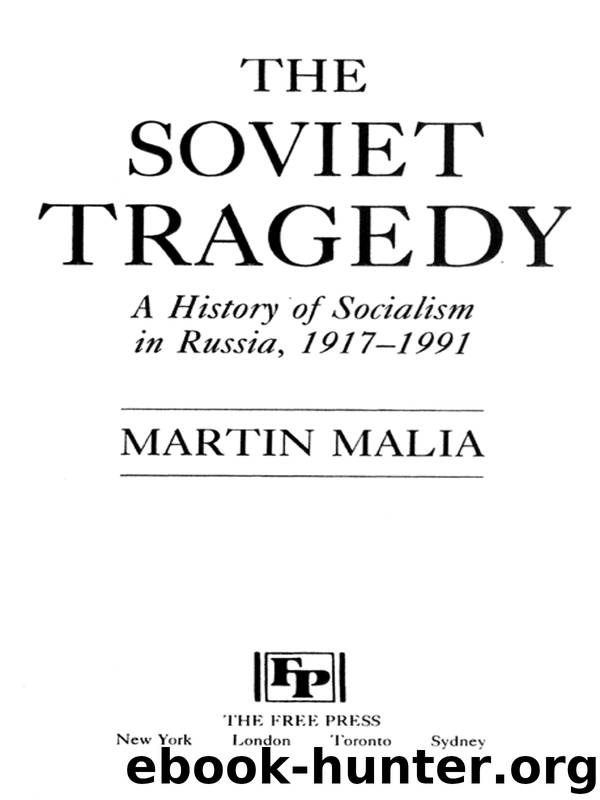Soviet Tragedy: A History of Socialism in Russia by Malia Martin

Author:Malia, Martin
Language: eng
Format: epub, azw3
Publisher: Free Press
Published: 2008-06-30T04:00:00+00:00
THE COLD WAR
Externally the Patriotic War brought the Soviet Union an empire, but internally it set her back almost to where she had been a decade earlier. Thus, if the Soviet Union after 1945 appeared ominously strong to the outside world, to its leaders it looked much too vulnerable for comfort or for any relaxation of effort by the population.
Despite the success in moving industry east of the Urals, the economy overall was devastated. The results of the Second and Third Five-Year Plans were largely undone. Agricultural production had declined by about one-half, and steel production, which was to have been twenty-three million tons in 1941, was now down to ten million tons. At the same time, the old administrative structures in the western, recently occupied parts of the country had been dismantled. The Soviet population—whether the troops who had been beyond Soviet borders or the civilians in the occupied zone—had been exposed to a relatively higher foreign living standard and freer alien ideas. The work of the thirties, therefore, had to be in large part redone.
And this was the essence of Stalin’s policy during his last years: he simply restored everything the war had partially undone—in politics, in the economy, and in culture. Yet the tone and style of this rebuilding of socialism were distinctly new. The thirties, for all their horror, had been an adventure; the late forties were a plodding restoration. There was no longer a trace of the militant leftism and the grim novelty of the first Five-Year Plans. The postwar years were a time of lead, not of steel; they were gray, not Red. Internally the last years of Stalin were the ice age of Sovietism, just as they were the high point of the Cold War externally.
Politically the war and postwar period marked the emergence of a mass Party appropriate to the new imperial tasks of the regime.14 During the war the Party had expanded from some 2.5 million members to 4 million (or from 3,400,000 to 5,760,000 if candidate members are included). This unprecedented expansion was carried out to give the Party a mass base in the all-important armed forces. After the war, however, as after earlier periods of rapid expansion in a time of crisis, large if unknown numbers of these hastily enrolled and minimally indoctrinated recruits were weeded out, though by and large not with the extreme methods of the Ezhovshchina. From 1947 onward, Party members were replaced only slowly, and they were selected much more carefully, as in the earlier periods of consolidation after 1921 and 1933. The result by the eve of Stalin’s death was a Party of 6 million members (6,880,000 with candidates), not all that much larger than it had been at the end of the war.
This greatly expanded Party, like the Party of the late thirties, was composed almost entirely of new Soviet men. It was even more clearly a Party of cadres; most members were from the managerial, technical, military, and administrative elites of the mature Soviet system, and there was only a decreasing number of workers and peasants.
Download
Soviet Tragedy: A History of Socialism in Russia by Malia Martin.azw3
This site does not store any files on its server. We only index and link to content provided by other sites. Please contact the content providers to delete copyright contents if any and email us, we'll remove relevant links or contents immediately.
| Anthropology | Archaeology |
| Philosophy | Politics & Government |
| Social Sciences | Sociology |
| Women's Studies |
The Secret History by Donna Tartt(18188)
The Social Justice Warrior Handbook by Lisa De Pasquale(11957)
Thirteen Reasons Why by Jay Asher(8461)
This Is How You Lose Her by Junot Diaz(6452)
Weapons of Math Destruction by Cathy O'Neil(5842)
Zero to One by Peter Thiel(5498)
Beartown by Fredrik Backman(5369)
The Myth of the Strong Leader by Archie Brown(5243)
The Fire Next Time by James Baldwin(5024)
How Democracies Die by Steven Levitsky & Daniel Ziblatt(4966)
Promise Me, Dad by Joe Biden(4912)
Stone's Rules by Roger Stone(4867)
100 Deadly Skills by Clint Emerson(4695)
A Higher Loyalty: Truth, Lies, and Leadership by James Comey(4557)
Rise and Kill First by Ronen Bergman(4548)
Secrecy World by Jake Bernstein(4394)
The David Icke Guide to the Global Conspiracy (and how to end it) by David Icke(4386)
The Farm by Tom Rob Smith(4329)
The Doomsday Machine by Daniel Ellsberg(4250)
